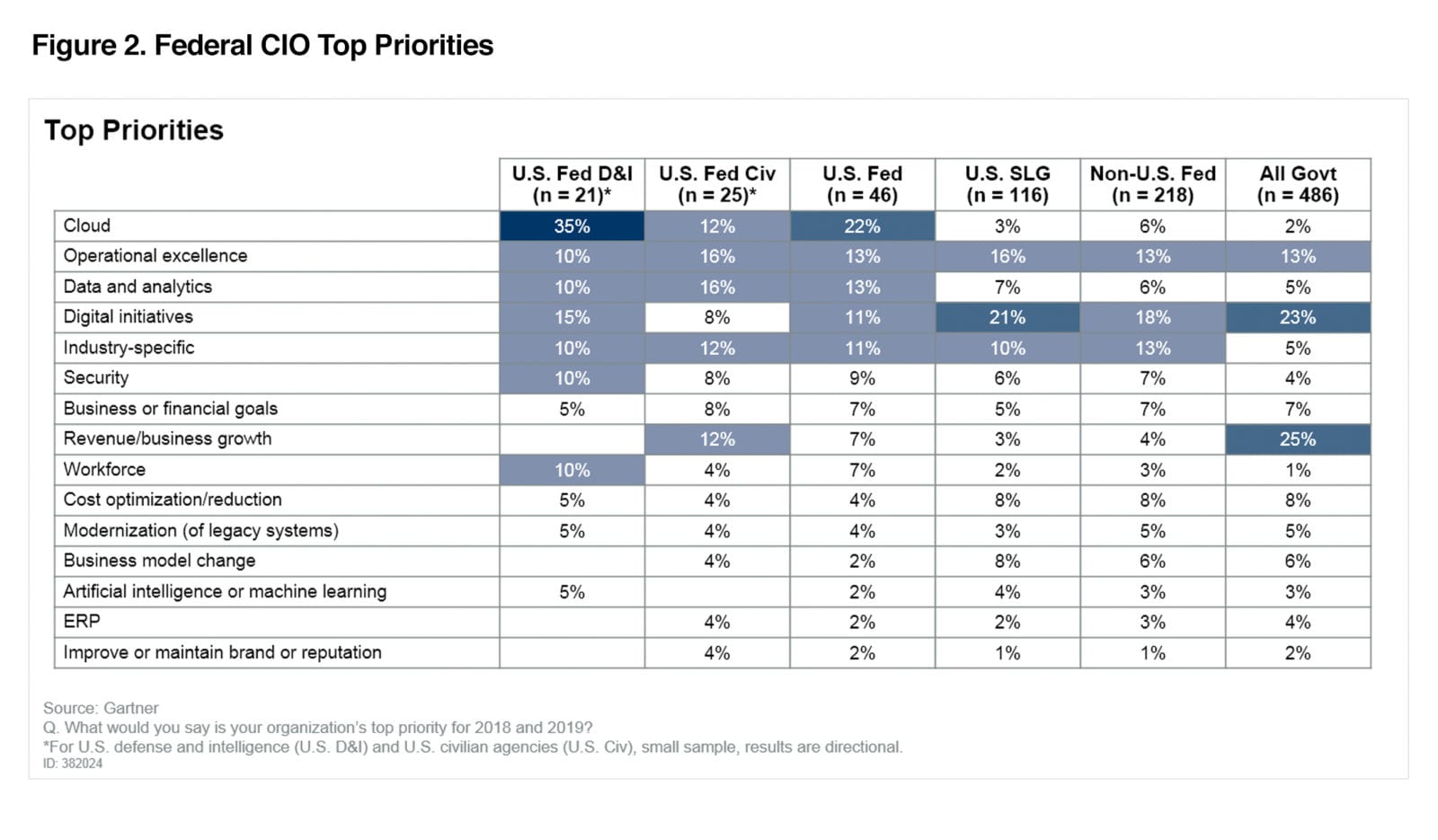5 Priorities for Federal CIOs
Federal CIOs have been tasked with modernizing their systems for employees and civilians. Here are 5 areas that CIOs can address to help prioritize technology-centered issues and invest wisely in new technology.

In the private sector, we see digital workplace and ecommerce companies using artificial intelligence (AI)-powered digital experiences as a differentiator for their employees and customers. Federal government agencies continue to feel the same pressure to invest in AI and modernize legacy systems to achieve their core missions.
With last year’s executive order on AI the White House publicly recognized the promise and potential of AI, and established priority for federal agencies to leverage this technology in order to further missions through modernization of clunky digital experiences for employees and citizens, increased employee productivity and satisfaction, and making information more easily accessible for civilians as a few examples.
But, where do you start?
There are five areas federal CIOs can look to in order to help prioritize their efforts for driving modernization strategies:
- Eliminate Technical Debt
- Seriously Consider Cloud
- Enable Data-Backed Decisions
- Invest in AI
- Modernize Digital Portals
Digital transformation strategies, in any industry, are most effective in small doses. Do not get lost in the challenge — focus on these five issues and tackle them one at a time, prioritizing what is most important based on your core mission.
1. Eliminate Technical Debt

Poor digital experiences are often a result of legacy systems that require an incredibly high amount of maintenance. Technical debt is a true lose-lose situation: high operations costs and your user experience is still suffering. In order to modernize more quickly, and avoid kicking the can down the road even further, start by reviewing your technical debt. Over time, legacy systems have accumulated, leaving IT to manage multiple, siloed softwares that could be streamlined or replaced completely. Keeping the lights on (KTLO) operations often associated with legacy applications provides a poor employee experience and can impede fulfillment of agency missions in a rapidly changing, dynamic world.
“CIOs, confronted by a huge volume of legacy systems, face significant modernization efforts in the near term. However, modernizing these systems opens opportunities to establish an architecture that better supports the next generation of government portals that provide the constituent-facing tools of digital government” (Government Portals Need to Evolve Now or They Won’t Satisfy Anyone, Gartner Inc., Bill Finnerty, Dean Lacheca, 3 March 2020).
2. Seriously Consider Cloud

After you have taken stock of your agency’s current technology investments, look for services that were created internally that could be replaced with a cloud offering. The main reason to move to the cloud is to offload the work that could be done more affordably by a cloud services provider. Legacy, heavily regulated industries like financial services and healthcare, often the slowest to modernize, are turning to the cloud for cost-savings and shifting their employees to more value-add, core mission work.
“Our customers are heavily concentrated in industries that have been around for over a century — government, healthcare, financial services, retail,” explains Will Hayes, Lucidworks CEO. “A lot of institutional information is still trapped behind in-person conversations, and these companies have historically been on the later edge of adopting new technologies. Every Global 2000 enterprise conversation of late has been focused on cloud.”
Cloud could be one of the biggest game-changers for federal agencies, but it can be difficult to get leadership on the same page. “Engage leadership in an ongoing conversation about organizational attitudes, expectations and risk perceptions about cloud services. Actively rebalance concerns about, and anticipated benefits from, cloud; in particular, scan for instances where attitudes and concerns are misplaced and causing missed opportunities.” (Top 10 Issues for U.S. Federal CIOs in 2019, Gartner Inc., Cathleen Blanton, Rick Holgate, 13 May 2019). “Rebalance concerns about, and anticipated benefits from, cloud; in particular, scan for instances where attitudes and concerns are misplaced and causing missed opportunities.”
3. Enable Data-Backed Decisions

Data and analytics capabilities are one of the top priorities for federal CIOs. Especially during times of crisis, a global pandemic for example, the need for advanced analytics is critical. “Leveraging agencywide data and advanced analytics can enable identification of bottlenecks and other sources of inefficiencies and opportunities for more effective and efficient operations through smarter allocation of limited resources” (Top 10 Issues for U.S. Federal CIOs in 2019, Gartner, Inc., Cathleen Blanton, Rick Holgate, 13 May 2019).

Top 10 Issues for U.S. Federal CIOs in 2019, Gartner Inc., Cathleen Blanton, Rick Holgate, 13 May 2019. This graphic was published by Gartner, Inc. as part of a larger research document and should be evaluated in the context of the entire document. The Gartner document is available upon request from Lucidworks.
Data aggregation and analysis with inclusion of both structured and unstructured data across silos provides leaders with a more complete picture. CIOs should have as much information available as possible before making decisions about what the key problems are and where to prioritize. Surfacing insights that the data provides is supported by the next key point: AI.
Click here for more information on how to launch a successful data analytics strategy.
4. Invest in AI

There are so many different use cases for AI and machine learning in the federal government it may be hard to know where and how to leverage this promising technology. This is why it is critical to aggregate your data and understand identified insights (Step 3) before making a big decision on where to prioritize investments in AI. Some areas to consider for initial investments: relevant and precise knowledge retrieval, providing a more personalized citizen experience in digital portals, streamlining application processes that are redundant or clunky or automating basic tasks from overworked staff.
One use case is AI-powered search. It is challenging for agencies to leverage knowledge across their entire organization, often minimizing the value of the data. Take the US Census Bureau for example: after collecting potentially 300 million census responses, there is an extensive amount of data and resulting reports which must be made available to political leaders, business leaders, and residents and done so quickly. Another example is Lucidworks customer AllMedx, which needed to make over 12 million documents easily accessible for physicians looking for the most relevant answers to clinical and point-of-care questions. Cutting-edge algorithms in Fusion, using AI and ML, made it possible to provide doctors with the answers they seek faster to achieve their core mission: caring for patients.
5. Modernize Digital Portals

Many of the points we have already discussed will play a role in modernizing your digital portal: minimize technical debt, offload unnecessary work through cloud migration, prioritize problem areas using data-backed insights, improve knowledge retrieval and create a personalized experience for employees and citizens with AI and machine learning. Another important step to consider is adding a conversational component to these digital portals to unburden your support staff, decrease call center expenses, and complete your core mission of getting information into the hands of people who need it.
“The outdated design and functionality of legacy portals in government are barriers to providing citizens with a quality, focused online experience” — (Government Portals Need to Evolve Now or They Won’t Satisfy Anyone, Gartner Inc., Bill Finnerty, Dean Lacheca, 3 March 2020)
Conversational applications, like chatbots or virtual assistants, powered by true intelligence allow users to help themselves. Now that in-person interactions have been severely restricted, it is critical that federal agencies find a way to manage the influx of website users. Users are increasingly eager to self-solve given frustrating and lengthy experiences with call centers and the aforementioned decrease of available in-person support.
Lucidworks customer Red Hat, introduced a self-solve based homepage to some of their customers. The data showed an increase in traffic for those customers directed to the new homepage, confirming that customers are really motivated to self-solve. Further, they saw a 7% decrease in new support cases created for those customers.
Start Smart
Federal CIOs across intelligence, defense, and civilian sectors are investing in major digital transformation. While this can be overwhelming, start smart by reducing agency technical debt, gain an understanding of the data you already have, and invest in new technologies that solve specific problems according to your priorities. It is important to take small (but informed!) steps to establish proofs of concept before you go big. Encourage a culture that continuously reevaluates use of technology and alignment to core mission and reap the benefits of a modern system.
Learn how Lucidworks helped the US Census Bureau transform their digital portal.
Best of the Month. Straight to Your Inbox!
Dive into the best content with our monthly Roundup Newsletter!
Each month, we handpick the top stories, insights, and updates to keep you in the know.